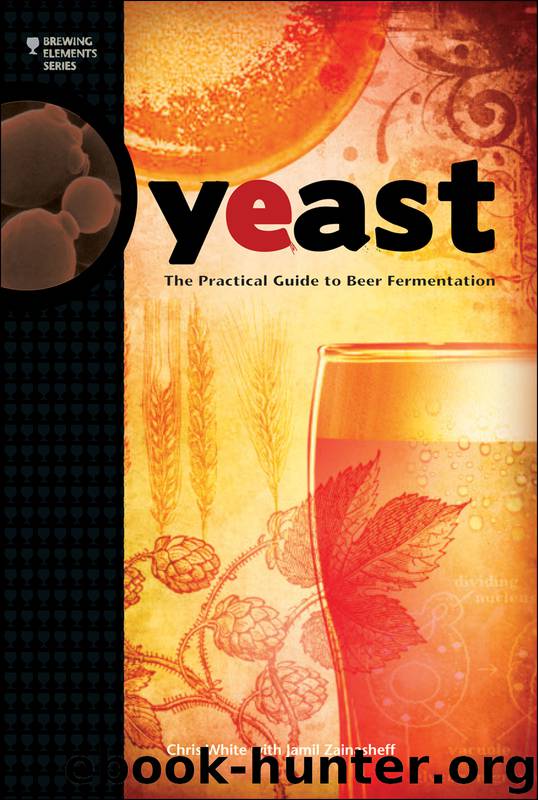Yeast by Chris White

Author:Chris White
Language: eng
Format: epub, mobi
Publisher: Brewers Association
Published: 2010-06-12T16:00:00+00:00
What Is the Best Starter Size?
The most important thing to know about starter size is that the inoculation rate affects the rate of growth. In other words, the “pitching rate” of your starter has a big effect on the amount of new yeast cells you will see from any propagation. It is not the volume of the starter that is important, but how many cells you add in relation to that volume. Too high an inoculation rate, and you get very little growth. If you use too low an inoculation rate, then you are not really making a starter, you are fermenting beer. Just as the pitching rate affects growth in a batch of beer, which is important to beer flavor, it also affects growth in a starter, although flavor does not matter.
Ideally, you want to grow your yeast in a large enough volume of wort to ensure optimal yeast health and to get a decent amount of growth for your trouble. Olau Nielsen introduced the concept of yield factor, which is a measure of the cell growth versus the amount of extract (sugars) consumed (Nielsen, 2005). It is a useful number to compare the effectiveness of propagation methods.
Yield Factor = (millions/ml cells final → millions/ml cells initial) / gravity decrease °P
For example, if you inoculate a 1 liter starter with 100 billion cells, that is 100 million per milliliter. If that starter grows to 152 billion cells, you have 152 million per milliliter at the end. Beginning with 9 °P wort and ending with 2 °P of sugar after the starter is complete, means the yeast used up 7 °P of sugar.
Yield Factor = (152 – 100) / 7 = 7.4
The more efficiently the yeast grows, the higher the yield factor. A yield factor greater than twenty indicates aerobic growth, and a number less than that is typical of anaerobic fermentation. Most homebrewers making starters never attain that level of growth. It requires very precise control of sugars and oxygen throughout the cycle to achieve such high growth rates. Not to worry, on a homebrew or small brewery scale, it is not critical to get every bit of growth possible. Yeast health and keeping the culture pure is far more important. However, it is useful to understand at what point you are not growing much yeast, at what point you are maximizing your growth, and at what point you are really just making beer.
One factor that makes it difficult for homebrewers to get a good yield is that they are often making a starter from a large population of yeast. The average liquid yeast package for homebrewers has about 100 billion cells. With that sort of culture, you need a large starter to get substantial growth.
We ran experiments using 100 billion cells of White Labs WLP001 in different starter sizes. We used vessels of the same material and height-to-width ratio for each starter. We added no supplemental oxygen or agitation of the starter, and all were at the same temperature of 70° F (21° C) and a specific gravity of 1.
Download
This site does not store any files on its server. We only index and link to content provided by other sites. Please contact the content providers to delete copyright contents if any and email us, we'll remove relevant links or contents immediately.
| Beer | Cocktails & Mixed Drinks |
| Coffee & Tea | Homebrewing, Distilling & Wine Making |
| Juices & Smoothies | Wine & Spirits |
101 Whiskies to Try Before You Die by Ian Buxton(44791)
World's Best Whiskies by Dominic Roskrow(44732)
Whiskies Galore by Ian Buxton(41867)
Craft Beer for the Homebrewer by Michael Agnew(18140)
Right Here, Right Now by Georgia Beers(4123)
Not a Diet Book by James Smith(3335)
Water by Ian Miller(3126)
The Coffee Dictionary by Maxwell Colonna-Dashwood(3062)
Kitchen confidential by Anthony Bourdain(3006)
Coffee for One by KJ Fallon(2561)
Smuggler's Cove: Exotic Cocktails, Rum, and the Cult of Tiki by Martin Cate & Rebecca Cate(2469)
Superfood Smoothie Bowls: Delicious, Satisfying, Protein-Packed Blends that Boost Energy and Burn Fat by Chace Daniella(2387)
Talking as Fast as I Can by Lauren Graham(2380)
Beer is proof God loves us by Charles W. Bamforth(2370)
Bourbon: A Savor the South Cookbook by Kathleen Purvis(2244)
A Short History of Drunkenness by Forsyth Mark(2233)
Eat With Intention by Cassandra Bodzak(2154)
Cocktails for the Holidays by Editors of Imbibe magazine(2080)
Colombia Travel Guide by Lonely Planet(2061)
